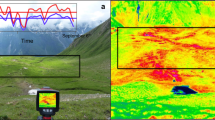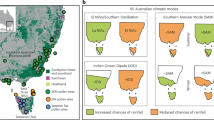Abstract
Advancing phenology in response to global warming has been reported across biomes1,2, raising concerns about the temporal uncoupling of trophic interactions3,4. Concurrently, widely reported flower visitor declines have been linked to resource limitations5. Phenological responses in the Arctic have been shown to outpace responses from lower latitudes and recent studies suggest that differences between such responses for plants and their flower visitors could be particularly pronounced in the Arctic1,6. The evidence for phenological uncoupling is scant because relevant data sets are lacking7 or not available at a relevant spatial scale8. Here, we present evidence of a climate-associated shortening of the flowering season and a concomitant decline in flower visitor abundance based on a long-term, spatially replicated (1996–2009) data set from high-Arctic Greenland. A unique feature of the data set is the spatial and temporal overlap of independent observations of plant and insect phenology. The shortening of the flowering season arose through spatial variation in phenological responses to warming. The shorter flowering seasons may have played a role in the observed decline in flower visitor abundance. Our results demonstrate that the dramatic climatic changes currently taking place in the Arctic are strongly affecting individual species and ecological communities, with implications for trophic interactions.
This is a preview of subscription content, access via your institution
Access options
Subscribe to this journal
Receive 12 print issues and online access
$209.00 per year
only $17.42 per issue
Buy this article
- Purchase on Springer Link
- Instant access to full article PDF
Prices may be subject to local taxes which are calculated during checkout




Similar content being viewed by others
References
Høye, T. T., Post, E., Meltofte, H., Schmidt, N. M. & Forchhammer, M. C. Rapid advancement of spring in the High Arctic. Curr. Biol. 17, R449–R451 (2007).
Menzel, A. et al. European phenological response to climate change matches the warming pattern. Glob. Change Biol. 12, 1969–1976 (2006).
Thackeray, S. J. et al. Trophic level asynchrony in rates of phenological change for marine, freshwater and terrestrial environments. Glob. Change Biol. 16, 3304–3313 (2010).
Both, C., Bouwhuis, S., Lessells, C. M. & Visser, M. E. Climate change and population declines in a long-distance migratory bird. Nature 441, 81–83 (2006).
Potts, S. G. et al. Global pollinator declines: Trends, impacts and drivers. Trends Ecol. Evol. 25, 345–353 (2010).
Høye, T. T. & Forchhammer, M. C. The influence of weather conditions on the activity of high-arctic arthropods inferred from long-term observations. BMC Ecol. 8, 8 (2008).
Miller-Rushing, A. J., Høye, T. T., Inouye, D. W. & Post, E. The effects of phenological mismatches on demography. Phil. Trans. R. Soc. B 365, 3177–3186 (2010).
Hegland, S. J., Nielsen, A., Lázaro, A., Bjerknes, A. L. & Totland, Ø. How does climate warming affect plant-pollinator interactions? Ecol. Lett. 12, 184–195 (2009).
Hinkler, J., Hansen, B. U., Tamstorf, M. P., Sigsgaard, C. & Petersen, D. Snow and snow-cover in central northeast Greenland. Adv. Ecol. Res. 40, 175–195 (2008).
Hülber, K., Winkler, M. & Grabherr, G. Intraseasonal climate and habitat-specific variability controls the flowering phenology of high alpine plant species. Funct. Ecol. 24, 245–252 (2010).
Wipf, S., Stoeckli, V. & Bebi, P. Winter climate change in alpine tundra: Plant responses to changes in snow depth and snowmelt timing. Climatic Change 94, 105–121 (2009).
Kudo, G. in Ecology and evolution of flowers (eds Harder, L. D. & Barrett, S. C. H.) 139–158 (Oxford Univ. Press, 2006).
Memmott, J., Craze, P. G., Waser, N. M. & Price, M. V. Global warming and the disruption of plant-pollinator interactions. Ecol. Lett. 10, 710–717 (2007).
Olesen, J. M. et al. Missing and forbidden links in mutualistic networks. Proc. R. Soc. B 278, 725–732 (2011).
Olesen, J. M., Bascompte, J., Elberling, H. & Jordano, P. Temporal dynamics in a pollination network. Ecology 89, 1573–1582 (2008).
Steltzer, H. & Post, E. Seasons and life cycles. Science 324, 886–888 (2009).
Aldridge, G., Inouye, D. W., Forrest, J. R. K., Barr, W. A. & Miller-Rushing, A. J. Emergence of a mid-season period of low floral resources in a montane meadow ecosystem associated with climate change. J. Ecol. 99, 905–913 (2011).
Post, E., Pedersen, C., Wilmers, C. C. & Forchhammer, M. C. Warming, plant phenology and the spatial dimension of trophic mismatch for large herbivores. Proc. R. Soc. B 275, 2005–2013 (2008).
Molau, U. Responses to natural climatic variation and experimental warming in two tundra plant species with contrasting life forms: Cassiope tetragona and Ranunculus nivalis. Glob. Change Biol. 3 (Suppl. 1), 97–107 (1997).
Jones, M. H., Bay, C. & Nordenhäll, U. Effects of experimental warming on arctic willows (Salix spp.): A comparison of responses from the Canadian High Arctic, Alaskan Arctic, and Swedish Subarctic. Glob. Change Biol. 3 (Suppl. 1), 55–60 (1997).
Menzel, A., Sparks, T. H., Estrella, N. & Roy, D. B. Altered geographic and temporal variability in phenology in response to climate change. Glob. Ecol. Biogeogr. 15, 498–504 (2006).
Iler, A. M., Høye, T. T., Schmidt, N. M. & Inouye, D. W. Long-term trends mask variation in the direction and magnitude of short-term phenological shifts. Am. J. Bot.http://dx.doi.org/10.3732/ajb.1200490 (in the press).
Høye, T. T. & Forchhammer, M. C. Phenology of high-arctic arthropods: Effects of climate on spatial, seasonal and inter-annual variation. Adv. Ecol. Res. 40, 299–324 (2008).
Larson, B. M. H., Kevan, P. G. & Inouye, D. W. Flies and flowers: Taxonomic diversity of anthophiles and pollinators. Can. Entomol. 133, 439–465 (2001).
Høye, T. T. & Sikes, D. S. Arctic entomology in the 21st century. Can. Entomol. 145, 125–1350 (2013).
Post, E. et al. Ecological dynamics across the Arctic associated with recent climate change. Science 325, 1355–1358 (2009).
Schmidt, N. M., Berg, T. B. & Meltofte, H. BioBasis—Conceptual Design and Sampling Procedures of The Biological Programme of Zackenberg Basic 13th edn (National Environmental Research Institute, 2010).
Elberling, B. et al. Soil and plant community-characteristics and dynamics at Zackenberg. Adv. Ecol. Res. 40, 223–248 (2008).
Klein, D. R., Bruun, H. H., Lundgren, R. & Philipp, M. Climate change influences on species interrelationships and distributions in high-arctic Greenland. Adv. Ecol. Res. 40, 81–100 (2008).
Meltofte, H. & Rasch, M. Zackenberg Ecological Research Operations. 3rd Annual Report 1997 (Danish Polar Center, Ministry of Research & Information Technology, 1998).
Acknowledgements
We thank the Zackenberg Basic monitoring program, Aarhus University, for providing access to ecosystem monitoring data. E.P. thanks the US National Science Foundation for support. J-M. Olesen and Y. Dupont gave valuable comments on an earlier draft of the manuscript.
Author information
Authors and Affiliations
Contributions
T.T.H. performed the statistical analyses, created the figures and wrote the first draft of the manuscript. E.P., M.C.F., N.M.S. and K.T. collaborated in writing the manuscript. N.M.S. and K.T. collaborated in planning the study, N.M.S. coordinated the field work and K.T. performed the preliminary analyses. All authors read and approved the final version of the manuscript.
Corresponding author
Ethics declarations
Competing interests
The authors declare no competing financial interests.
Supplementary information
Rights and permissions
About this article
Cite this article
Høye, T., Post, E., Schmidt, N. et al. Shorter flowering seasons and declining abundance of flower visitors in a warmer Arctic. Nature Clim Change 3, 759–763 (2013). https://doi.org/10.1038/nclimate1909
Received:
Accepted:
Published:
Issue Date:
DOI: https://doi.org/10.1038/nclimate1909
This article is cited by
-
Plant–pollinator network change across a century in the subarctic
Nature Ecology & Evolution (2023)
-
Diverging trends and drivers of Arctic flower production in Greenland over space and time
Polar Biology (2023)
-
Global effects of land-use intensity on local pollinator biodiversity
Nature Communications (2021)
-
A reflection on four impactful Ambio papers: The biotic perspective
Ambio (2021)
-
Phenological shifts of abiotic events, producers and consumers across a continent
Nature Climate Change (2021)



